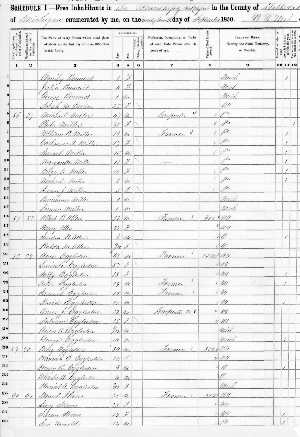
The Record - January 1998
Family History
Connie Potter and Claire Prechtel-Kluskens, Editors
Clues in Census Records, 1850-1920
by Claire Prechtel-Kluskens
Experienced genealogical researchers use clues found in one record to find other
records about the same individual. This article describes some of the clues found
in census records.
Date of Birth
The 1900 census (column 7) indicates the person's month and year of birth; the 1850-1880 and 1910-1920 censuses indicates the person's age. The 1870 census (column 13) and 1880 census (column 7) indicate the month in which the person was born, if born "within the last year," that is between June 1, 1869-May 31, 1870 for the 1870 census, or June 1, 1879-May 31, 1880, for the 1880 census. The official census day was June 1 in both 1870 and 1880, although the enumerator may have visited the household at a later date. While the person's age is not an exact date of birth, it at least provides a "ballpark" figure useful in case other persons have the same name for tracking the person from one census to another and locating the person in any existing vital records.
Place of Birth
The 1850-1920 censuses indicate the person's state or country of birth, which helps narrow the geographic scope of search for the specific town of birth.
Date of Marriage
The 1850 census (column 10), 1860 census (column 11), and 1880 census (column 12) indicate whether the person had married within the last year. "Within the last year" means during the year before the official census day, that is, between June 1, 1849-May 31, 1850, for the 1850 census; between June 1, 1859-May 31, 1860, for the 1860 census; and between June 1, 1879-May 31, 1880, for the 1880 census. The 1870 census (column 14), indicates the month in which the person was married, if married "within the last year," again, between June 1, 1869-May 31, 1870. The official census day was June 1 in each of these census years, although the enumerator may have visited the household at a later date. The 1900
census (column 10) and 1910 census (column 9) asks married persons how many years they had been married.
Number of Children
The 1900 census (column 11) and 1910 census (column 10) asks how many children were born to each woman. The 1900 census (column 12) and 1910 census (column 11) asks how many of those children were still living. These clues can help the researcher determine whether all children in a given family have been identified, and whether any were deceased when either census was taken.
Other clues include the following:
Immigration
The 1900 census (column 16), 1910 census (column 15), and 1920 census (column
13) each indicate the person's year of immigration to the United States.. This
information should help in locating a ship passenger arrival list. Naturalization.
The 1870 census (column 19) has a check mark for "Male Citizens of the U.S.
of 21 years of age and upwards." If the person was a foreign- born citizen,
this means that he had become naturalized by 1870. The 1900 census (column 18)
and the 1920 census (column 15) both indicate the year in which the person was
naturalized. The 1900 census (column 18), the 1910 census (column 16), the 1920
census (column 14) ask the person's naturalization status. The answers are "Al"
for alien, "Pa" for "first papers," and "Na" for naturalized. For more information
about naturalization records, see our Naturalization Records web page.
Foreign-born Parents
The 1870 census (columns 11-12) indicates if the person's parents were "of
foreign birth." The 1880 census (columns 25-26), 1900 census (columns 14-15),
1910 census (columns 13-14), and 1920 census (columns 21 & 23), ask the person'
parents' birthplaces.
Service in Union or Confederate Army or Navy
The 1910 census (column 30) asks whether the person is a "survivor of the
Union or Confederate Army or Navy." The answers are "UA" for Union Army, "UN"
for Union Navy, "CA" for Confederate Army, and "CN" for Confederate Navy. These
clues lead to military service and pension records; for more information, see
our Civil War Records web page.
A word of caution--columns 30-32 are often "overwritten" with numbers like 2-1-0-0
or 6-9-0-0. These numbers are not the answers the columns 30-32, but were data
summaries used by Census Bureau tabulators in Washington, DC, to compile statistical
data.
Real Property
The 1850 census (column 8) and 1860 census (column 8) both indicate the
value of real property (land) owned by each person. The 1900 census (column
25), 1910 census (column 26), and 1920 census (column 7) indicates whether the
person owned ("O") or rented ("R") the home or farm. The 1900 census (column
26), 1910 census (column 27), and 1920 census (column 8) asked home and farm
owners whether the property had a mortgage ("M") or was free of mortgage ("F").
These clues should lead researchers to the county recorder's office or equivalent
agency for deeds, mortgages, and property tax records.
Economic Data
The 1850 census (column 7), 1860 census (column 7), 1870 census (column
7), and 1880 census (column 13) all ask for the person's occupation. If the
answer is "farmer," the researcher should look for information about the farmer's
land ownership, crops, and livestock in the agricultural census schedules. If
the person was a saw or grist miller, cheese maker, or other "manufacturer,"
the researcher should check the manufacturing census schedules." For more information
and suggestions, see Claire Prechtel-Kluskens, "The Nonpopulation Census Schedules,"
The Record, vol. 2, No. 1 (1995): 9, 25. Agricultural census schedules exist
for 1850-1880; manufacturing census schedules exist for 1820 and 1850-1880.
Conclusion
Researchers who use these and other clues in census records will be more
successful--and thorough--in their genealogical research.

Note: Claire Prechtel-Kluskens is an archivist with NARA's User Services Branch at Archives I.